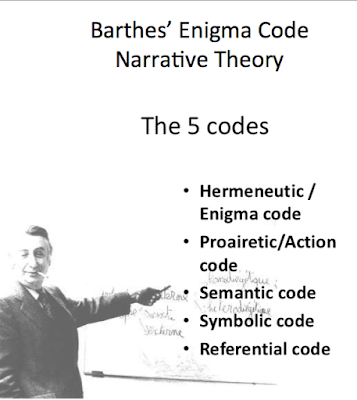LUTHER
TODOROV
This is the theory that every film or narrative follows the same pattern. Equilibrium, disequilibrium, acknowledgement, solution. In Luther season 4 episode 1 and 2 there are several narratives. The first being between Alice Morgan and our Hero Luther, Alice is found to be dead and so Luther does his best to solve her murder. In this instance the equilibrium is Luther living peacefully in his home by the coast, the disequilibrium is him finding out that Alice has died in a car 'accident', that meant she drowned in a river, the acknowledgement is Luther realising that her death was not an accident but in fact a murder. However, Luther does not really follow Todorov's theory as Luther's tracking down of Alice's killer leads him into another disequilibrium and another narrative. This is when he kidnaps George Cornelius and so when he escapes a bounty is put on his head, putting Luther in trouble.
Simultaneously there is another narrative running along side, with Stephen Rose murdering and eating specific parts of peoples bodies and Leo and Emma chasing him down, this of course is the disequilibrium but this is then followed by another disequilibrium when Leo is killed in an explosion and so Luther has to join the case and so both narratives are fused together. The acknowledgement of this narrative is when they come to the understanding that Stephen has Cotard delusion where the affected person believes they are dead and have lost their internal organs and so the specific body parts that Stephen is eating are to make up what he's lost.
There is another disequilibrium in the Alice-Luther story when a girl named Megan claims to have a message for Luther from Alice, which questions whether she is actually dead. The acknowledgement comes when Megan claims she is psychic. However, this again leads into another disequilibrium as it turns out Megan is using Luther so that he actually fulfils the promise he gave to her as a little girl that he'd protect her from Stacey. Then the George and Luther narratives overlap when Luther has to cut his and Megan's chat short over fear of another hit.
There is then another disequilibrium in the Stephen Rose narrative as he kidnaps his ex-girlfriend and her children. There is then a solution to this narrative when Emma puts a bullet in Stephen's head as revenge for killing Leo. Luther then finds Megan's safety deposit box with diamonds and the phones she stole to keep an eye on Luther.
The George Cornelius, Luther, Alice and Megan narratives all overlap when Luther gives George the diamonds Alice was going to sell so she and Luther could run away and in return the hit is called off and Luther asks for drugs and pills. The solution the Megan and Luther narrative is found as Luther stuffs the drugs in the owl teddy bear. Stacey is then arrest with intent to supply but the teddy will link her to a murder she committed. There is then a semi-solution to the Alice-Luther-megan story as Megan admits to murdering Alice but there is then a disequilibrium again as Luther vows to get Megan.
PROPP
The Villain(s)- Stephen, George and Stacey all of these characters become problems for Luther as they are all at the head of the cases for him to solve.
The Donor-
The Helper- Emma, Leo, George they all play big parts in him providing a solution to the problems. For example, Emma kills Stephen and prevents the death of his ex girlfriend and George gives Luther the drugs to farm Stacey.
The Princess- Alice Morgan she is Luther's love interest and is the reason he resumes his line of work.
The Father-
The Dispatcher- Megan and Leo. When Leo dies it brings Luther back into the case and Megan gives Luther the reason to frame Stacey.
The Hero- Luther he is the main protagonist of the series as it revolves around his life and he is pinnacle is the solving and conclusion of each case.
The Anti-Hero - Luther does not always do the right thing like when he kidnapped George but he has the right intention.
The False Hero- Megan, she at first seems to be Luther's friend giving him information about the case which is close to his heart but she is actually using him for her case and it turns out she killed his lover.
BARTHE
Proairetic Code- This is shown when Stephen pulls a knife out on his ex-girlfriend and you think he is going to stab her.
Semantic Code- The fridge- normally just seen as an everyday appliance but when it explodes on Leo it becomes a source of fear. So when Luther approaches the fridge tension builds as people believe its a bomb.
The Dead Bird- This foreshadows the events of what will happen to the woman as she throws the bird out.
Enigma Code- At the end of episode one, Megan has a message for Luther from Alice, this frustrates audiences as they are left questioning whether she is alive or dead.
Referential Code- This would refer to the Cotard delusion which is a mental illness where the affected person believes they are dead.






















